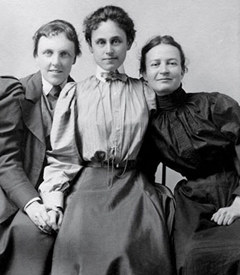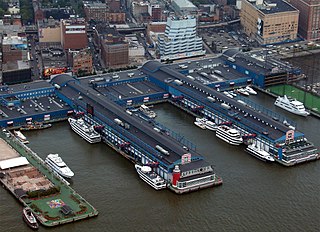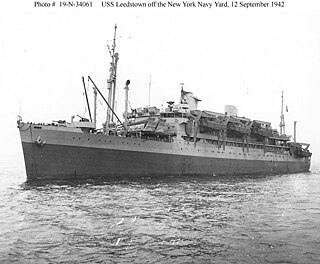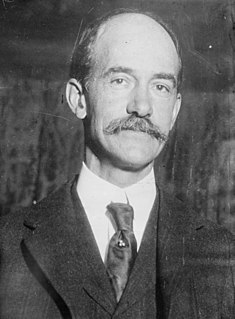Related Research Articles
Transatlantic crossings are passages of passengers and cargo across the Atlantic Ocean between Europe or Africa and the Americas. The majority of passenger traffic is across the North Atlantic between Western Europe and North America. Centuries after the dwindling of sporadic Viking trade with Markland, a regular and lasting transatlantic trade route was established in 1566 with the Spanish West Indies fleets, following the Voyages of Christopher Columbus.

Theodate Pope Riddle was an American architect and philanthropist. She was one of the first American women architects as well as a survivor of the sinking of the RMS Lusitania.

Chelsea Piers is a series of piers in Chelsea, on the West Side of Manhattan in New York City. Located to the west of the West Side Highway and Hudson River Park and to the east of the Hudson River, they were originally a passenger ship terminal in the early 1900s that was used by the RMS Lusitania and was the destination of the RMS Carpathia after rescuing the survivors of the RMS Titanic. The piers replaced a variety of run-down waterfront structures with a row of grand buildings embellished with pink granite facades.

The National Jewish Welfare Board (JWB) was formed on April 9, 1917, three days after the United States declared war on Germany, in order to support Jewish soldiers in the U.S. military during World War I. The impetus for creating the organization stemmed from Secretary of War, Newton Baker and Secretary of Navy, Josephus Daniels. The organization was also charged with recruiting and training rabbis for military service, as well as providing support materials to these newly commissioned chaplains. The JWB also maintained oversight of Jewish chapel facilities at military installations.

Paul César Helleu was a French oil painter, pastel artist, drypoint etcher, and designer, best known for his numerous portraits of beautiful society women of the Belle Époque. He also conceived the ceiling mural of night sky constellations for Grand Central Terminal in New York City. He was also the father of Jean Helleu and the grandfather of Jacques Helleu, both artistic directors for Parfums Chanel.
The Travelers Aid movement began in St. Louis, Missouri, under the leadership of Mayor Bryan Mullanphy. Its purpose was to provide assistance to American pioneers and new immigrants who became stranded on their journeys. At his death in 1851, Mullanphy left a bequest of a half million dollars in his will to help "aid travelers going west."
Grace Hoadley Dodge was an American philanthropist who was the first woman appointed a member of the New York Board of Education.

Rockaway Park is a neighborhood in the New York City borough of Queens. The area is on the Rockaway Peninsula, nestled between Jamaica Bay to the north and the Atlantic Ocean to the south. The neighborhood of Rockaway Beach lies on its eastern border while the community of Belle Harbor is situated on its western side. The neighborhood is part of Queens Community Board 14.

The RMS Teutonic was an ocean liner built for the White Star Line in Belfast and was the first armed merchant cruiser.

Belle Moskowitz was an important political influencer in the early 20th century. In her obituary, the New York Times referred to her as the most powerful woman in United States politics. She worked as a political advisor and publicist to New York Governor and 1928 Democratic presidential candidate Al Smith.

Edward Murray Bassett, "the father of American zoning", and one of the founding fathers of modern-day urban planning, wrote the first comprehensive zoning ordinance in the United States, which was adopted by New York City in 1916. He also served as a U.S. Representative for New York.

USS Leedstown (AP-73), built as the Grace Line passenger and cargo ocean liner SS Santa Lucia, served as a United States Navy amphibious assault ship in World War II. The ship had first been turned over to the War Shipping Administration (WSA) and operated by Grace Line as the WSA agent from February to August 1942 in the Pacific. In August the ship, at New York, was turned over to the Navy under sub-bareboat charter from WSA. She was sunk 9 November 1942 off the Algerian coast by a German submarine after German bombers caused damage the day before.

SS La Touraine was an ocean liner that sailed for the Compagnie Générale Transatlantique from the 1890s to the 1920s. Built in France in 1891, she was primarily employed in transatlantic service on the North Atlantic. The liner was scrapped in Dunkirk in October 1923.
This is a timeline of the world's largest passenger ships based upon internal volume, initially measured by gross register tonnage and later by gross tonnage. This timeline reflects the largest extant passenger ship in the world at any given time. If a given ship was superseded by another, scrapped, or lost at sea, it is then succeeded. Some records for tonnage outlived the ships that set them - notably the SS Great Eastern, and RMS Queen Elizabeth.

William Church Osborn was the son of a prominent New York City family who served in a variety of civic roles including president of the Metropolitan Museum of Art, president of the Children's Aid Society, and president of the New York Society for the Relief of the Ruptured and Orphaned.

Orin Clarkson Baker was General Secretary of the Travelers Aid Society of New York (TAS-NY) from 1911-1917. The TAS-NY was formed by Grace Hoadley Dodge in 1907 to protect native-born and immigrant women from the moral dangers, especially "white slavery", that were thought to be rampant at urban train stations and piers. Upon Dodge's death in 1914, Orin Baker became the face of the Travelers Aid movement in New York and the United States. He criss-crossed the country to promote travelers' aid as a legitimate subfield of the emerging social work profession. While in California, he helped establish the Travelers Aid Society of California for the purpose of providing travelers' aid to the female visitors of the 1915 Panama-Pacific International Exposition. Under his leadership, local Travelers Aid Societies and similar organizations were federated to form the National Travelers Aid Society in 1917. That same year he published the first travelers' aid textbook, Travelers Aid Society in America. Baker abruptly resigned from both the Travelers Aid Society of New York and the National Travelers Aid Association in 1919 when he thought Board members were attempting to undermine his authority within the movement.

Aurora "Lola" Greene Baldwin was an American woman who became one of the first policewomen in the United States. In 1908, she was sworn in by the City of Portland as Superintendent of the Women's Auxiliary to the Police Department for the Protection of Girls, with the rank of detective.

Grace Gallatin Seton Thompson was an American author and suffragist.

The history of sexual slavery in the United States is the history of slavery for the purpose of sexual exploitation as it exists in the United States.
The New England Female Moral Reform Society was originally called the Boston Female Moral Reform Society at the time it was founded in 1835. The group changed their name in 1838 in response to a rivalry with the New York Female Moral Reform Society for support among women in auxiliary societies. The goal of the New England Female Moral Reform Society, as well as the other moral reform societies at the time, was to prevent prostitution and to end the sexual double standard. In 1844 the society opened a home for reformed prostitutes. In the first volume of their semi-monthly periodical, the society asserted that men and women were equally liable for the immoral sexual actions that they performed together.
References
- ↑ "Guide to the Records of the Travelers Aid Society of New York". New-York Historical Society. Retrieved 2011-12-14.
- ↑ Perry, Elizabeth (2000). Belle Moskowitz. Boston: Northeastern University Press, p. 34.
- ↑ McCall, Bertha (1950). History of the National Travelers Aid Association, 1911-1948. New York, pp. 3-5.
- ↑ Cimino, Eric (Winter 2016). "The Travelers' Aid Society: Moral Reform and Social Work in New York City, 1907-1916". New York History. 97 (1): 35, 42–45. doi:10.1353/nyh.2016.0003. S2CID 165850174.
- ↑ McCall. History of National Travelers Aid. pp. 31-33. Cimino, "Travelers' Aid Society," p. 50